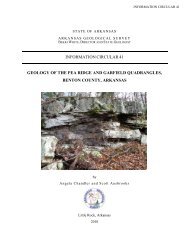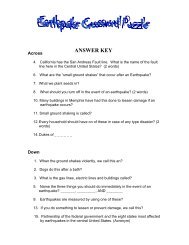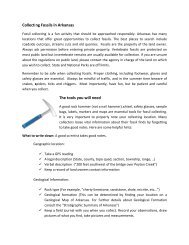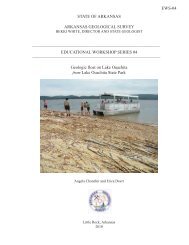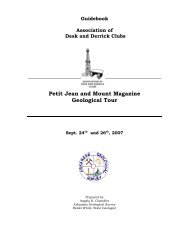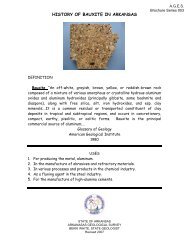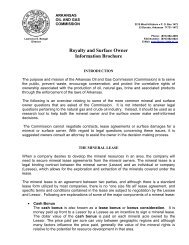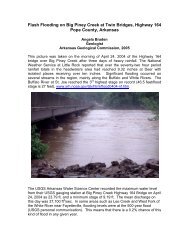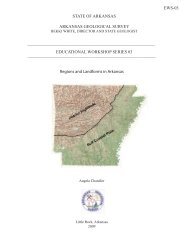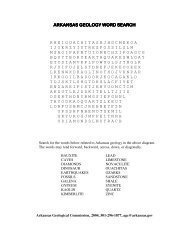Mining, Minerals and More in the Western Ouachita Mountains
Mining, Minerals and More in the Western Ouachita Mountains
Mining, Minerals and More in the Western Ouachita Mountains
- No tags were found...
Create successful ePaper yourself
Turn your PDF publications into a flip-book with our unique Google optimized e-Paper software.
The mercury district occurs <strong>in</strong> a belt 12 miles wide <strong>and</strong> 50 miles long extend<strong>in</strong>g from easternHoward County through Pike County <strong>and</strong> <strong>in</strong>to western Clark County (Fig. 12). The two areas ofgreatest concentration of m<strong>in</strong><strong>in</strong>g were just west of <strong>the</strong> Anto<strong>in</strong>e River <strong>and</strong> on both sides of <strong>the</strong>Little Missouri River.At our fieldtrip location, <strong>the</strong> mercury ore occurs <strong>in</strong> s<strong>and</strong>stone units near <strong>the</strong> top of <strong>the</strong> StanleyShale. The s<strong>and</strong>stone is gray <strong>and</strong> made up of a f<strong>in</strong>e to medium gra<strong>in</strong>ed mosaic of rounded tosub-angular gra<strong>in</strong>s of quartz with m<strong>in</strong>or amounts of shale, white angular feldspar gra<strong>in</strong>s <strong>and</strong>flakes of mica. Locally, <strong>the</strong> s<strong>and</strong>stone may conta<strong>in</strong> quartz <strong>and</strong> chert pebbles.C<strong>in</strong>nabar is <strong>the</strong> only primary ore m<strong>in</strong>eral <strong>in</strong> <strong>the</strong> district. Freshly exposed c<strong>in</strong>nabar is translucent<strong>and</strong> bright vermillion red. The c<strong>in</strong>nabar occurs as f<strong>in</strong>e to medium crystall<strong>in</strong>e coat<strong>in</strong>gs onfracture surfaces <strong>and</strong> as coarsely crystall<strong>in</strong>e material fill<strong>in</strong>g larger fractures <strong>and</strong> open spaces.Dickite <strong>and</strong> quartz also crystallized with <strong>the</strong> c<strong>in</strong>nabar <strong>and</strong> are associated with it <strong>in</strong> <strong>the</strong> fracturefill<strong>in</strong>gs. Dickite is a soft white to light brown clay m<strong>in</strong>eral. It is often powdery or has a f<strong>in</strong>egra<strong>in</strong>edappearance. Dickite is present at all of <strong>the</strong> m<strong>in</strong>es <strong>and</strong> prospects <strong>in</strong> <strong>the</strong> district. Quartzoccurs as small clear crystals <strong>and</strong> as massive milky quartz <strong>in</strong> fractures <strong>and</strong> open spaces.C<strong>in</strong>nabar <strong>and</strong> o<strong>the</strong>r primary m<strong>in</strong>erals were deposited from aqueous solutions ris<strong>in</strong>g throughfractures <strong>and</strong> porous rock. These mercury bear<strong>in</strong>g solutions were probably <strong>the</strong> result ofepi<strong>the</strong>rmal discharges of fluids from metamorphic rocks at depth west of <strong>the</strong> presentm<strong>in</strong>eralized area (Howard, 1979). It is thought that <strong>the</strong> solutions traveled northward up faultplanes <strong>and</strong> <strong>in</strong>to fractured s<strong>and</strong>stones <strong>and</strong> fault breccias where c<strong>in</strong>nabar was precipitated <strong>in</strong>open spaces. Ore bodies occur as pipe-like bodies <strong>in</strong> association with m<strong>in</strong>or folds <strong>and</strong> faults <strong>and</strong>as tabular bodies generally restricted to an <strong>in</strong>dividual s<strong>and</strong>stone bed or a small group of beds.11



